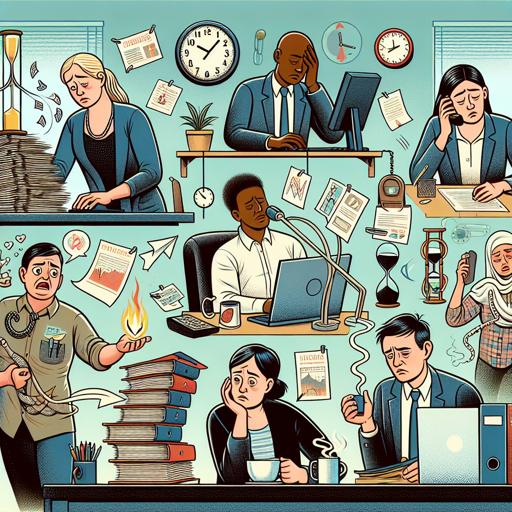In today’s fast-paced and demanding work environment, overcoming burnout and stress in the workplace has become a critical priority for professionals across all industries. As the pressure to meet deadlines and achieve targets intensifies, many individuals find themselves grappling with feelings of exhaustion and overwhelm.
This blog aims to explore effective strategies and practices that can help alleviate these burdens, fostering a healthier and more balanced work life. By understanding the root causes of burnout and implementing proactive measures, employees can regain their energy, enhance productivity, and cultivate a more positive and sustainable work atmosphere.
Understanding the causes and symptoms of workplace burnout and stress

In the ever-spinning carousel of corporate life, burnout and stress are like those uninvited guests who always seem to crash the party. They sidle in unnoticed at first, whispering tales of exhaustion and whispers of discontent. To truly vanquish workplace fatigue and tension, it’s essential to shine a spotlight on these unwelcome intruders, unraveling their origins and manifestations.
Delve into the world of chronic exhaustion, and you’ll find that burnout often blossoms from a cocktail of relentless deadlines, unrealistic expectations, and a lack of support. It’s akin to constantly revving an engine without scheduled maintenance—eventually, something’s bound to seize up.
Recognizing the symptoms of workplace burnout is akin to detecting the scent of smoke before a fire overtakes the room. Many professionals may experience chronic fatigue, irritability, and a noticeable decline in performance, like a star performer gradually withdrawing from the limelight. You might notice them hovering around the office coffee machine a bit longer than necessary or sighing heavily over their keyboards.
An important step in overcoming workplace stress and fatigue involves creating an environment where these warning signs are not only recognized but addressed with empathy and action. Encouraging open dialogues about workload and promoting a culture that values mental well-being can be pivotal in extinguishing the flames of burnout.
Solutions to overcoming these challenges require that organizations, and not just individuals, recalibrate their approach. Flexibility, not rigidity, should mark the order of the day.
Implementing supportive strategies such as regular mental health check-ins, offering resources for stress management, or even arranging periodic breaks to recharge can reinvigorate the workplace dynamic. Remember, a well-rested mind is not just good for business productivity; it also fosters creative sparks and problem-solving prowess. By transforming the workplace into a nurturing space, where humans can rediscover a sense of balance and fulfillment, the menace of workplace burnout and stress might slowly but surely retreat into the shadows.
Effective strategies for managing stress in a high-pressure work environment

Navigating the relentless tides of a high-pressure work setting can feel akin to taming a tempestuous sea, with the specter of workplace burnout lurking like a lurking kraken beneath the surface. But fret not, for effective strategies exist to navigate these choppy waters and emerge unscathed. One particularly illuminating beacon is the art of setting boundaries.
By defining clear lines between work life and personal life, you reclaim precious time for self-care and reflection. Picture an elite athlete, who despite their rigorous training, allocates ample time for rest and recovery.
This strategic pause is not laziness but mastery of professional endurance, ensuring they remain in peak form for when the race demands it. Just as these athletes thrive by respecting their limits, so too can you stave off burnout by cherishing your off-the-clock hours as an inviolable sanctuary of rejuvenation.
Another clever tactic involves transforming your workspace into an oasis of calm amidst the hustle and bustle. A well-considered environment can work wonders for your stress levels. This transformation might involve introducing verdant houseplants, which have been scientifically shown to boost mood and productivity.
Imagine the subtle, grounding presence of a resilient fern offering you a verdant wink from the corner of your desk, inviting you to pause, breathe, and reset. Implement noise-cancelling headphones or soothing background music to muffle the cacophony of an open-plan office.
The trick is to create a mental escape hatch, allowing you to periodically check out and recharge your mental batteries without stepping away. As you embark on this mindful metamorphosis, remember that your workspace is not merely a cluster of desks and chairs; it is the cockpit of your professional life. By taking control of it, you steer the narrative away from stress and toward serenity, outsmarting the looming specter of burnout with grace and intelligence.
The role of work-life balance in preventing burnout

In the grand juggling act that is modern life, achieving work-life balance can often feel like trying to keep a circus tent standing in a hurricane. Yet, this elusive equilibrium is not just a lofty ideal; it is an essential cornerstone in the battle against workplace burnout.
Imagine your work-life balance as a finely tuned see-saw; on one end, your professional responsibilities and deadlines may seem insurmountable. On the other, your personal life beckons with its siren call of leisure, family, and reflection. Achieving harmony between these two poles is pivotal not just for sanity, but for sustainable productivity.
The insidious nature of stress in the workplace often stems from a misalignment between personal goals and professional obligations. When the scales tip too far into work territory, stress levels can skyrocket, leading to burnout. Overcoming burnout and stress is a strategic endeavor that requires a proactive rebalancing of priorities.
Picture a contented worker: their day is a clever composition where work is but a movement in the symphony of life, not a never-ending solo concerto. Those who master this balance often find themselves more engaged, with the cognitive bandwidth to creatively tackle challenges without succumbing to mental exhaustion.
On the practical side, fostering a healthy work-life proportion may involve setting boundaries as firm as a Zen master’s resolve during morning meditation or implementing time management techniques worthy of a Tetris champion. Organizations too have a role to play, advocating for a culture where mental health is as important as meeting milestones.
Flexible hours, the option to work remotely, and provision for uninterrupted personal time can be pivotal. The result? A workforce that is not merely surviving but thriving.
Indeed, when balance is achieved, work transforms from a burdensome chore into a satisfying dance, making overcoming burnout and stress not just possible but almost enjoyable.
Building a supportive workplace culture to combat stress
In the bustling world of modern workspaces, the demands of the job can often leave employees feeling like candles burning at both ends. A supportive workplace culture can be the antidote to this predicament, acting as the guiding lighthouse amid these stormy seas of stress.
By fostering an environment where everyone feels valued and understood, businesses have the opportunity to not only enhance employee well-being but to significantly increase overall productivity. Think of it like planting seeds; when nourished with positivity and understanding, relationships and efficiency blossom beautifully, thereby creating a harmonious symphony of cooperation and innovation. A robust support system acts as the safety net that catches individuals before they fall into the abyss of burnout, maintaining both morale and motivation.
Let’s paint a picture of vibrancy. Imagine a team where cross-functional communication isn’t marred by dread, but eagerly embraced; where leadership isn’t merely about command but about empowering each voice in the room.
Promoting open dialogue and providing platforms for expressing concerns can revolutionize the workplace atmosphere, diminishing the sources of stress long before they evolve into burnout. Managers stepping up as mentors, rather than mere taskmasters, and introducing wellness programs rooted in empathy rather than obligation, can go a long way toward quelling the tide of workplace exhaustion. Vibrant social activities, flexible working hours, and logical workloads are among the many colors that can enrich this masterpiece, transforming workplaces from stress factories into vibrant ecosystems that thrive on mutual support.
Investing in this kind of culture isn’t just about altruism; it’s a strategic move with hands firmly planted on the pulse of potential. Employees who perceive that their workplace genuinely cares for their mental and emotional health cultivate loyalty and perseverance—qualities that any employer would cherish.
Moreover, when the atmosphere is charged with positivity and collaboration, creativity flows more freely, allowing for breakthrough results that surpass the traditional grindstone outcomes. By addressing these stressors head-on, and reimagining the cultural landscape of our workplaces, organizations can create sanctuaries where both individuals and ideas not only survive but flourish, narrating a compelling story of success interwoven with compassion and common purpose.
The importance of self-care and mindfulness in overcoming burnout
Burnout may sound like a calamity reserved for overenthusiastic pyrotechnics, but anyone who’s endured the smoldering workplace embers of stress knows it’s an all-too-real phenomenon. Imagine being caught in a hamster wheel, sprinting but never gaining ground, exhaustion nipping at your heels. This relentless cycle can drain even the most robust spirits if not interrupted by intentional self-care and the artful practice of mindfulness.
Like a master gardener tending to a wilting plant, these practices nourish the soul, providing the hydration and sunlight necessary to transform from a state of exhaustion into a thriving being. Self-care serves as the foundation upon which recovery from occupational stress is built.
It’s the mixed bag of hobbies, habits, and little indulgences that empower you to hit “refresh. ” Though it may not take the form of grand gestures, it makes an impactful statement by reminding individuals of their innate value.
Whether it’s savoring a favorite book in a cozy nook or nurturing creativity through painting, self-care reinforces the notion that life exists beyond deadlines and quarterly reports. This intentional reclamation of personal time acts as a counterbalance to the relentless demands that leave one feeling like a human pretzel twisted in a jumble of tasks. Parallel to self-care’s restoration lies mindfulness—a serene Jedi of calm that trains the practitioner to focus on the present moment, freeing them from the shackles of past regrets and future anxieties.
Realignment of attention from the chaos of external stresses to internal peace is tantamount to taking back control. Engaging in practices such as mindful breathing or meditation carves out mental expanses where clarity can flourish unfettered.
Mindfulness doesn’t merely silence stress; it tunes the inner dialogue to a more harmonious frequency, enabling a dance through life with grace and intention. As one integrates these practices into daily life, overcoming burnout becomes less of an audacious struggle and more a gentle return to a state of intrinsic serenity, allowing one to thrive rather than just survive in the workplace.
Nasza rekomendacja wideo
Podsumowanie
In summary, overcoming burnout and stress in the workplace involves recognizing the signs early, setting boundaries, prioritizing self-care, and seeking support when needed. Implementing mindfulness practices, taking regular breaks, and fostering a supportive work environment can significantly enhance well-being and productivity.
By actively addressing stressors, employees can cultivate resilience and maintain a healthier work-life balance.
Najczęściej zadawane pytania
What are the early signs of burnout and stress in the workplace, and how can employees recognize them before they escalate?
Early signs of burnout and stress in the workplace include chronic fatigue, irritability, decreased productivity, and detachment, and employees can recognize them by regularly self-assessing their emotional and physical well-being and seeking support when these symptoms persist.
Sure, please provide the question you’d like me to answer.
How can employers create a supportive work environment that helps prevent burnout and stress among their employees?
Employers can create a supportive work environment by promoting work-life balance, offering mental health resources, encouraging open communication, and recognizing employee achievements.
Sure, please provide the question you’d like me to answer.
What practical strategies can individuals implement in their daily routines to manage and reduce workplace stress effectively?
Individuals can effectively manage and reduce workplace stress by incorporating regular breaks, practicing mindfulness or meditation, prioritizing tasks, setting boundaries for work-life balance, and engaging in physical exercise.
Sure, please provide the question you’d like answered.
How does work-life balance contribute to reducing burnout, and what steps can employees take to achieve a healthier balance?
Work-life balance reduces burnout by allowing individuals to recharge and maintain mental well-being, and employees can achieve this by setting boundaries, prioritizing tasks, and scheduling regular breaks and leisure activities.
Sure, please provide the question you’d like me to answer.
What role does communication play in addressing workplace stress, and how can employees and managers improve their communication skills to alleviate stress?
Communication plays a crucial role in addressing workplace stress by fostering understanding, reducing misunderstandings, and promoting a supportive environment, and employees and managers can improve their communication skills by actively listening, providing clear and constructive feedback, and encouraging open dialogue.
Sure, please provide the question you’d like me to answer.
How can mindfulness and mental health resources be integrated into the workplace to support employees in overcoming burnout and stress?
Mindfulness and mental health resources can be integrated into the workplace by offering regular mindfulness sessions, providing access to mental health professionals, and fostering a supportive environment that encourages open conversations about stress and burnout.
